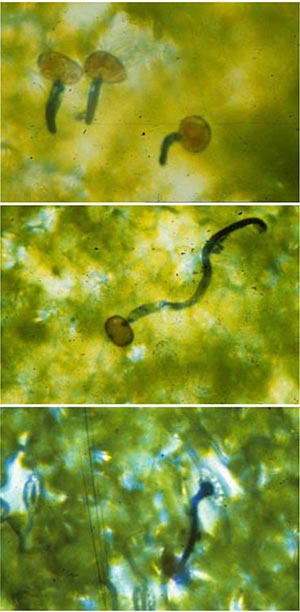G1766
Rust of Dry Bean
Rust is an important disease of dry beans in eastern Colorado, western Nebraska, and adjacent regions in the central High Plains. Periodic epidemics have occurred in the region since the 1950s and documented yield losses have exceeded 50 percent in some situations.
Robert M. Harveson, Extension Plant Pathologist, Panhandle Research and Extension Center
Howard F. Schwartz, Extension Plant Pathologist, Colorado State University
James R. Steadman, Professor, Plant Pathology
- Signs and Symptoms
- Source of Infection and Spread
- Factors Favoring Epidemics
- Management
- Worksheet for Determining Strategies for Fungicide Applications in Dry Beans
Signs and Symptoms
Rust is caused by the obligate fungus Uromyces appendiculatus. Symptoms initially appear as small yellow or white slightly raised spots on upper and/or lower leaf surfaces (Figure 1). These spots enlarge and form reddish-brown pustules, also called uredinia, that are about 1/8 inch or smaller and contain thousands of microscopic spores called urediniospores. These spores can re-infect plants under favorable conditions and continue the disease process, or can serve as a method of long distance dispersal of the pathogen. Pustules may be surrounded by a yellow border (Figure 2). Spores are readily released from pustules and give plants and anything they contact a rusty appearance. Rust can be distinguished from other foliar diseases because the rust-colored spores will rub off (Figure 3), while with other foliar diseases, nothing rubs off.
Severe infections cause leaves to curl up, dry up, turn brown, and drop prematurely. A severely rusted bean field often appears scorched (Figures 4 and 5). Pod set, pod fill, and seed size can be reduced if infection is severe. Green pods, and occasionally stems and branches, also may become infected and develop typical rust symptoms.
Near the end of the season, pustules undergo a subtle change and form telia containing brownish-black winter spores (teliospores) (Figure 6) signaling the end of the current infection cycle (Figure 7).
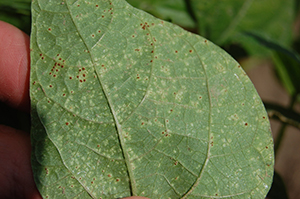 |
 |
|
Figure 1. Early uredinial pustules consisting of small, raised white spots |
Figure 2. Advanced uredinial pustules surrounded with yellow borders containing reddish-brown repeating spores |
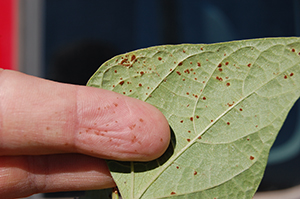 |
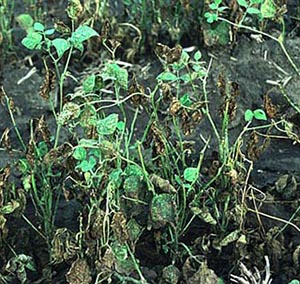 |
|
Figure 3. Urediniospores rub off on finger after making contact with pustules |
Figure 4. Severely infected bean plants |
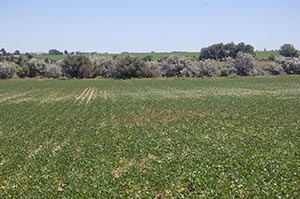 |
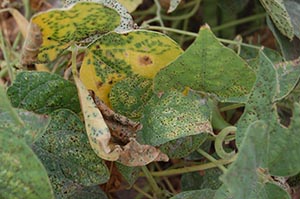 |
|
Figure 5. Severely infected bean plants shown from a distance (browning and necrotic patches) |
Figure 6. Pustules late in season containing dark, overwintering teliospores |
Source of Infection and Spread
Two potential sources of rust inoculum (spores) that initiate an epidemic are locally overwintered teliospores and airborne urediniospores blown in from distant bean fields (Figure 7).
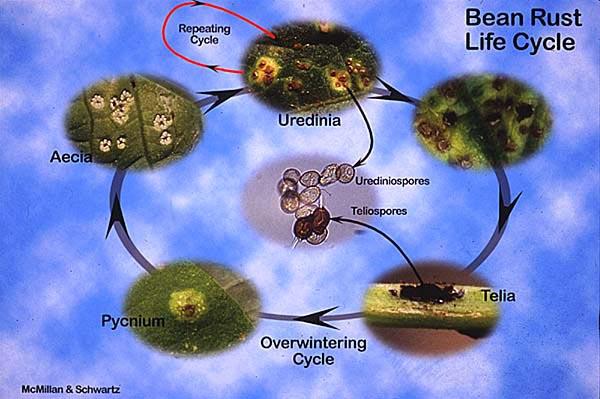 |
Figure 7. Life cycle of rust disease in dry bean |
|
Rust spores, particularly teliospores, overwinter in bean straw in some regions of the U.S., including the central High Plains. Teliospores germinate in the spring and produce basidiospores that are aerially dispersed onto volunteer or newly seeded bean plants in late May or early June. Volunteer plants in fields of irrigated corn and winter wheat often are unnoticed sources of inoculum. Bean plants become infected by basidiospores that initiate specialized types of white pustules called pycnia and aecia (Figure 7). These pustules are visible for only a few days and are difficult to detect. Spores produced from these pustules (aeciospores) eventually infect other bean plants and the characteristic reddish-brown repeating (urediniospores) spore stage develops, usually on leaves. This has contributed to rust epidemics in this region and is a factor in northern bean-growing states such as North Dakota and Minnesota.
Rust usually appears in the central High Plains in mid-summer after pod set, when urediniospores from distant bean production areas to the south and/or urediniospores and aeciospores from infected local volunteer beans are transported by wind and deposited on leaves. These spores germinate to produce structures that enter a leaf through the plant stomates (breathing pores) (Figure 8). They develop within host tissue to form a small white uredinial spot or blister (Figure 1) in five to seven days and mature reddish-brown pustules (Figure 2) in 10 to 14 days.
Factors Favoring Epidemics
Rust development is favored by cool to moderate temperatures (70-85°F) and moist conditions such as prolonged periods of water (more than 10 hours) on leaf surfaces. Rain, dew, and sprinkler irrigation are common sources of moisture. Cool, wet conditions during May and June favor early season infection of volunteer beans by the overwintering stages. The same conditions in July and August will affect the rate of disease development and spread to new beans. Under favorable conditions disease cycles may repeat every 10 to 14 days.
The earlier the plant becomes infected during its development, the greater the chance for yield loss. Anything that delays plant maturity, such as late planting, herbicide damage, excess nitrogen, or hail damage, increases the potential for significant yield loss in the event that a rust epidemic occurs. This potential is also increased by planting on or adjacent to old bean ground where the rust pathogen survived through the winter. Infection that occurs within 21 days of knifing may reduce seed size but will not significantly affect yield.
Management
No single disease management technique will prevent rust fungus infection. Integrating management practices (cultural, host resistance, chemical) will provide more long-term and reliable crop protection. Cultural practices such as crop rotation and burial of bean debris will remove potential sources of inoculum. Planting within recommended periods for this region (May 15 to June 15) will reduce late season exposure to high levels of the pathogen and conditions favorable for disease development — cool nights that produce dew. Sprinkler irrigation can be timed to avoid foliage staying wet at night for more than 10 hours.
Most older bean varieties are susceptible to rust. Rust-resistant varieties are constantly being developed and are available for many market classes, including pinto, great northern, small white, red kidney, and black beans.
Rust-resistant pinto varieties developed recently by University of Nebraska and Colorado State University bean breeders and pathologists may yield nearly 200 percent more than susceptible varieties when exposed to severe epidemics. However, the value and stability of this resistance can be affected by the variability in pathogen virulence.
University researchers continue to monitor area fields for the presence of new pathogen races capable of overcoming resistance incorporated into commercial varieties and advanced breeding lines. This information will guide deployment of rust resistance genes alone or in combinations for future bean varieties.
The effectiveness of current resistance can be extended by integrating the previously described cultural practices and sound use of protectant and/or systemic fungicides.
To evaluate whether a fungicide treatment is needed, scout fields frequently during late vegetative to early pod development for initial rust pustules. Infections occurring at or after pod bump and stripe seldom cause significant economic losses, but may reduce seed size. To help determine the need for implementing fungicide applications, use the worksheet included here and developed in Colorado based on varietal susceptibility, rust severity the previous season, weather data, and date of first sign or symptoms. For example, if the variety is susceptible and the total score is 10 or higher, treatment with a labeled fungicide such as Maneb/Manex (30-day preharvest interval = phi), Endura, Headline, Priaxor, or Vertisan (21 day phi), Bravo/Terranil, Folicur or Quadris (14 day phi), Proline (7 day phi), or Fontelis (0 day phi) should be considered at the first confirmed signs of rust (often in the R1 to R3 stages) on numerous plants in the field or nearby region. Repeat applications if needed, depending on disease pressure and the fungicide selected, until 14 to 30 days phi or the R7 growth stage is reached, whichever occurs first.
Worksheet for Determining Strategies for Fungicide Applications in Dry Beans
RISK CATEGORIES for the BEAN COMMON RUST Disease Forecast (update on a weekly basis) |
Your Score |
|||
| Total Rainfall (inches), summarize cumulative rainfall weekly up to V4 Growth Stage | ||||
Less than 0.1” [ 1 ] |
0.1-0.5” [ 2 ] |
0.5-1.0” [ 3 ] |
More than 1” [ 4 ] |
|
| Daily High Temperature (F), summarize weekly up to V4 Growth Stage | ||||
Less than 76°F [ 4 ] |
76-81°F [ 3 ] |
81-86°F [ 2 ] |
More than 86°F [ 1 ] |
|
| Forecasted Total Rainfall (inches), weekly between V4 and R4 Growth Stages | ||||
Less than 0.1” [ 1 ] |
0.1-0.5” [ 2 ] |
0.5-1.0” [ 3 ] |
More than 1” [ 4 ] |
|
| Forecasted Daily High Temperature (F), weekly between V4 and R4 Growth Stages | ||||
Less than 76°F [ 4 ] |
76-81°F [ 3 ] |
81-86°F [ 2 ] |
More than 86°F [ 1 ] |
|
| Forecasted Average Wind Speed (mph), weekly between V4 and R4 Growth Stages | ||||
Less than 1 mph [ 1 ] |
1-5 mph [ 2 ] |
5-10 mph [ 3 ] |
More than 10 mph [ 4 ] |
|
| Bean Rotation of less than 3 years and/or Volunteer Beans Observed Nearby (within 2 miles) | ||||
No beans (3 yr), No Volunteers [ 1 ] |
Recent Beans OR Volunteers Nearby [ 2 ] |
Recent Beans and Volunteers Nearby [ 4 ] |
||
| Yield Potential Estimate-in relation to plant population, fertility, irrigation inputs, current growing season | ||||
Low [ 1 ] |
Moderate [ 2 ] |
High [ 4 ] |
||
| Irrigation Practice/Schedule after Mid to Full Flower or R2 Growth Stage | ||||
No Irrigation — Rainfed Only [ 1 ] |
Less than 0.25”/day [ 2 ] |
More than 0.25”/day [ 4 ] |
||
| Varietal Reaction to Prevalent Races of Common Bean Rust | ||||
Resistant [ 1 ] |
Unknown [ 2 ] |
Susceptible [ 4 ] |
||
Common Rust Disease Risk-Total Score: |
||||
If your Total Score is: More than 25 = High Risk |
| If the susceptible variety is planted in a field or region with a history of disease and the total score is 20 or higher, consider treatment with a labeled fungicide at the first confirmed sign of disease (often the R1 to R3 growth stages) on numerous plants in the field or nearby fields. Follow a 5- to 10-day interval between sprays, depending on disease pressure and the fungicide selected until the preharvest interval or the R7 growth stage is reached, whichever occurs first. Pesticide information is available on the High Plains Integrated Pest Management website at http://www.highplainsipm.org/. |
This publication has been peer reviewed.
DisclaimerReference to commercial products or trade names is made with the understanding that no discrimination is intended of those not mentioned and no endorsement by University of Nebraska–Lincoln Extension is implied for those mentioned. |
Visit the University of Nebraska–Lincoln Extension Publications website for more publications.
Index: Plant Diseases
Dry Bean
2007, Revised October 2013
